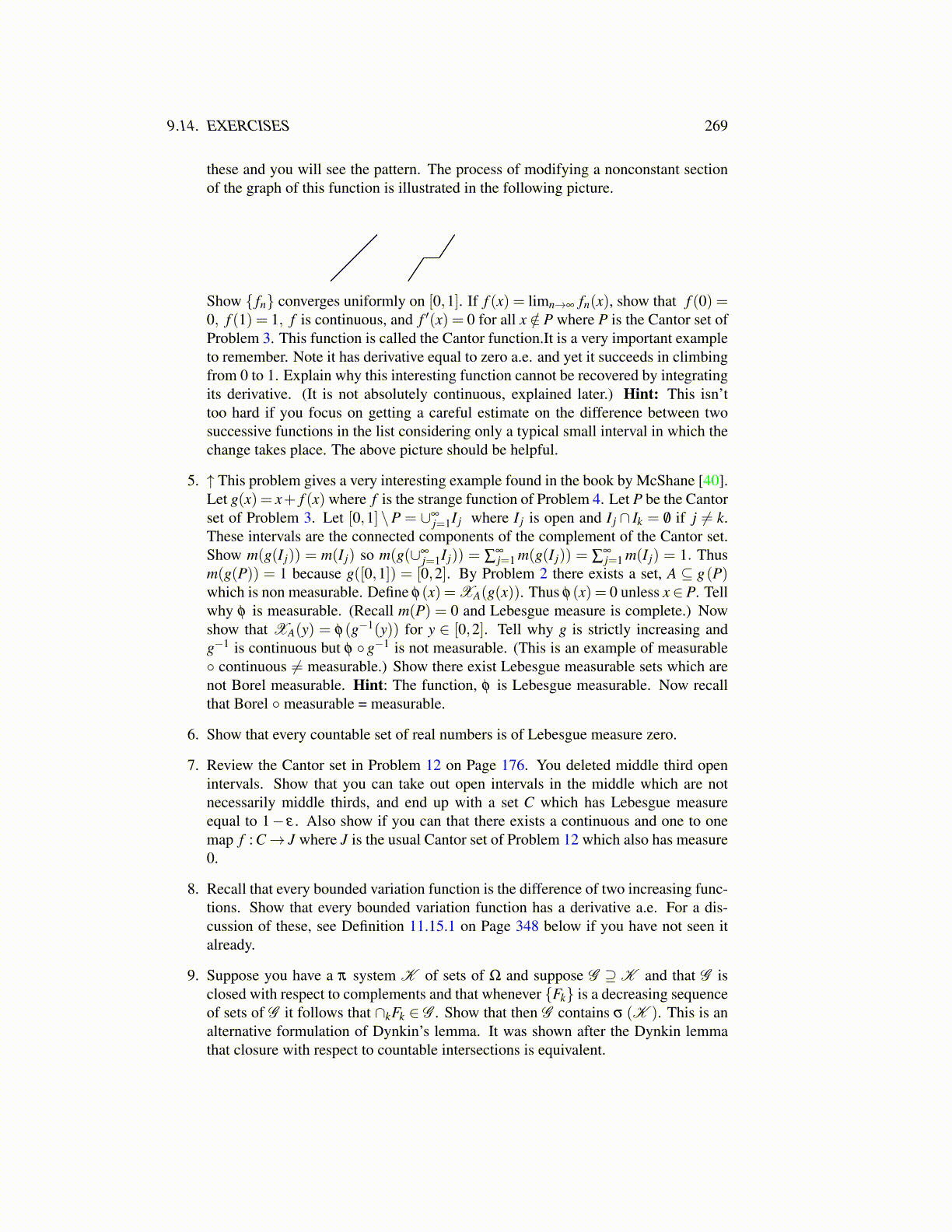
9.14. EXERCISES 269
these and you will see the pattern. The process of modifying a nonconstant sectionof the graph of this function is illustrated in the following picture.
Show { fn} converges uniformly on [0,1]. If f (x) = limn→∞ fn(x), show that f (0) =0, f (1) = 1, f is continuous, and f ′(x) = 0 for all x /∈ P where P is the Cantor set ofProblem 3. This function is called the Cantor function.It is a very important exampleto remember. Note it has derivative equal to zero a.e. and yet it succeeds in climbingfrom 0 to 1. Explain why this interesting function cannot be recovered by integratingits derivative. (It is not absolutely continuous, explained later.) Hint: This isn’ttoo hard if you focus on getting a careful estimate on the difference between twosuccessive functions in the list considering only a typical small interval in which thechange takes place. The above picture should be helpful.
5. ↑ This problem gives a very interesting example found in the book by McShane [40].Let g(x) = x+ f (x) where f is the strange function of Problem 4. Let P be the Cantorset of Problem 3. Let [0,1] \P = ∪∞
j=1I j where I j is open and I j ∩ Ik = /0 if j ̸= k.These intervals are the connected components of the complement of the Cantor set.Show m(g(I j)) = m(I j) so m(g(∪∞
j=1I j)) = ∑∞j=1 m(g(I j)) = ∑
∞j=1 m(I j) = 1. Thus
m(g(P)) = 1 because g([0,1]) = [0,2]. By Problem 2 there exists a set, A ⊆ g(P)which is non measurable. Define φ(x) =XA(g(x)). Thus φ(x) = 0 unless x∈ P. Tellwhy φ is measurable. (Recall m(P) = 0 and Lebesgue measure is complete.) Nowshow that XA(y) = φ(g−1(y)) for y ∈ [0,2]. Tell why g is strictly increasing andg−1 is continuous but φ ◦g−1 is not measurable. (This is an example of measurable◦ continuous ̸= measurable.) Show there exist Lebesgue measurable sets which arenot Borel measurable. Hint: The function, φ is Lebesgue measurable. Now recallthat Borel ◦ measurable = measurable.
6. Show that every countable set of real numbers is of Lebesgue measure zero.
7. Review the Cantor set in Problem 12 on Page 176. You deleted middle third openintervals. Show that you can take out open intervals in the middle which are notnecessarily middle thirds, and end up with a set C which has Lebesgue measureequal to 1− ε . Also show if you can that there exists a continuous and one to onemap f : C→ J where J is the usual Cantor set of Problem 12 which also has measure0.
8. Recall that every bounded variation function is the difference of two increasing func-tions. Show that every bounded variation function has a derivative a.e. For a dis-cussion of these, see Definition 11.15.1 on Page 348 below if you have not seen italready.
9. Suppose you have a π system K of sets of Ω and suppose G ⊇K and that G isclosed with respect to complements and that whenever {Fk} is a decreasing sequenceof sets of G it follows that ∩kFk ∈ G . Show that then G contains σ (K ). This is analternative formulation of Dynkin’s lemma. It was shown after the Dynkin lemmathat closure with respect to countable intersections is equivalent.